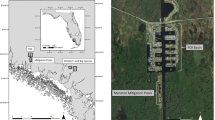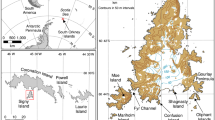Abstract
Strandings of marine mammals, seabirds, and marine turtles in coastal areas can provide valuable information on their ecology. However, gathering information by field teams often incur high costs and effort. This study evaluated the effectiveness of an Unmanned Aerial Vehicle (UAV) to detect stranded animals during beach monitoring programs. The study was carried out between 2016 and 2017 evaluating factors related to the UAV (height and camera angle) and the beach (morphology). Data obtained from the UAV was compared with the traditional method of in situ teams. A total of 120 aerial surveys were conducted on four beaches on the coast of Santa Catarina, Brazil. Eighteen carcasses were recorded by both methods, traditional methodology and UAV. However, six other events were only recorded by in situ monitoring (traditional method) and one event recorded only by the UAV. The time interval between the beach monitoring by the two strategies is probably responsible for the differences. Despite obtaining high-quality aerial images and easily identifying strandings, the UAV cannot completely replace the traditional method due mainly to the impossibility to fly in adverse weather conditions such as high winds and rain. On the other hand, UAVs can complement the data collection information, with less consumption of fossil fuels and damage to the coastal environment.






Similar content being viewed by others
References
Adame K, Pardo MA, Salvadeo C et al (2017) Detectability and categorization of California sea lions using an unmanned aerial vehicle. Mar Mam Sci 33:913–925. https://doi.org/10.1111/mms.12403
Aguilera M, Medina-Suárez M, Pinós J et al (2019) Assessing the effects of multiple off-road vehicle (ORVs) tyre ruts on seaward orientation of hatchling sea turtles: implications for conservation. J Coast Conserv 23:111–119. https://doi.org/10.1007/s11852-018-0641-x
Balmer JE, Ylitalo GM, Rowles TK et al (2018) Persistent organic pollutants (POPs) in blood and blubber of common bottlenose dolphins (Tursiops truncatus) at three northern Gulf of Mexico sites following the Deepwater Horizon oil spill. Sci Total Environ 621:130–137. https://doi.org/10.1016/j.scitotenv.2017.11.209
Barros LSC, Leuzinger MD (2019) O uso de drones como instrumento para a conservação da biodiversidade no Brasil. RDI 16. https://doi.org/10.5102/rdi.v16i2.6164
Bevan E, Wibbels T, Najera BMZ, Martinex MAC, et al (2015) Unmanned aerial vehicles (UAVs) for monitoring sea turtles in near-shore waters. Mar Turtle Newsl 145:19–22
Bevan E, Whiting S, Tucker T et al (2018) Measuring behavioral responses of sea turtles, saltwater crocodiles, and crested terns to drone disturbance to define ethical operating thresholds. PLoS ONE 13:e0194460. https://doi.org/10.1371/journal.pone.0194460
Brisson-Curadeau É, Bird D, Burke C et al (2017) Seabird species vary in behavioural response to drone census. Sci Rep 7:17884. https://doi.org/10.1038/s41598-017-18202-3
Christie KS, Gilbert SL, Brown CL et al (2016) Unmanned aircraft systems in wildlife research: current and future applications of a transformative technology. Front Ecol Environ 14:241–251. https://doi.org/10.1002/fee.1281
Crespo EA, Pedraza SN, Dans SL, Koen Alsonso M, Reyes LM, García NA, Coscarella M, Schiavini CM (1997) Direct and indirect effects of highseas fisheries on the marine mammal populations in the Northern and Central Patagonian Coast. J Northw Atl Fish Sci 22:189–207. https://doi.org/10.2960/J.v22.a15
Dehvari A, Heck RJ (2012) Removing non-ground points from automated photo-based DEM and evaluation of its accuracy with LiDAR DEM. Comput Geosci 43:108–117. https://doi.org/10.1016/j.cageo.2012.02.013
Fettermann T, Fiori L, Bader M et al (2019) Behaviour reactions of bottlenose dolphins (Tursiops truncatus) to multirotor Unmanned Aerial Vehicles (UAVs). Sci Rep 9:8558. https://doi.org/10.1038/s41598-019-44976-9
Fox CH, O’Hara PD, Bertazzon S et al (2016) A preliminary spatial assessment of risk: Marine birds and chronic oil pollution on Canada’s Pacific coast. Sci Total Environ 573:799–809. https://doi.org/10.1016/j.scitotenv.2016.08.145
Goebel ME, Perryman WL, Hinke JT et al (2015) A small unmanned aerial system for estimating abundance and size of Antarctic predators. Polar Biol 38:619–630. https://doi.org/10.1007/s00300-014-1625-4
Groom G, Petersen IK, Anderson MD, Fox AD (2011) Using object-based analysis of image data to count birds: mapping of lesser flamingos at Kamfers Dam, Northern Cape, South Africa. Int J Remote Sens 32:4611–4639. https://doi.org/10.1080/01431161.2010.489068
Haney JC, Jodice PGR, Montevecchi WA, Evers DC (2017) Challenges to oil spill Assessment for Seabirds in the Deep Ocean. Arch Environ Contam Toxicol 73:33–39. https://doi.org/10.1007/s00244-016-0355-8
Hodgson A, Kelly N, Peel D (2013) Unmanned Aerial Vehicles (UAVs) for surveying Marine Fauna: a Dugong Case Study. PLoS ONE 8:e79556. https://doi.org/10.1371/journal.pone.0079556
INMET - Instituto Nacional de Meteorologia (2017). http://www.inmet.gov.br/portal/index.php?r=estacoes/estacoesAutomaticas. Accessed 22 Mar 2020
Jones GP, Pearlstine LG, Percival HF (2006) An assessment of small unmanned aerial vehicles for wildlife research. Wildl Soc Bull (1973–2006) 34:750–758
Kelaher BP, Colefax AP, Tagliafico A et al (2019) Assessing variation in assemblages of large marine fauna off ocean beaches using drones. Mar Freshw Res. https://doi.org/10.1071/MF18375
Koh LP, Wich SA (2012) Dawn of drone ecology: low-cost autonomous aerial vehicles for conservation. Trop Conserv Sci 5:121–132. https://doi.org/10.1177/194008291200500202
Kudo H, Koshino Y, Eto A et al (2012) Cost-effective accurate estimates of adult chum salmon, Oncorhynchus keta, abundance in a japanese river using a radio-controlled helicopter. Fish Res 119–120:94–98. https://doi.org/10.1016/j.fishres.2011.12.010
Meager JJ, Sumpton WD (2016) Bycatch and strandings programs as ecological indicators for data-limited cetaceans. Ecol Ind 60:987–995. https://doi.org/10.1016/j.ecolind.2015.08.052
Moreland EE, Cameron MF, Angliss RP, Boveng PL (2015) Evaluation of a ship-based unoccupied aircraft system (UAS) for surveys of spotted and ribbon seals in the Bering Sea pack ice. J Unmanned Veh Sys 3:114–122. https://doi.org/10.1139/juvs-2015-0012
Pomeroy P, O’Connor L, Davies P (2015) Assessing use of and reaction to unmanned aerial systems in gray and harbor seals during breeding and molt in the UK. J Unmanned Veh Sys 3:102–113. https://doi.org/10.1139/juvs-2015-0013
Pontalti M, Danielski M (2011) Registros de enredamentos de baleias-franca, Eubalaena australis (CETACEA, MISTICETI), na temporada reprodutiva de 2010, em Santa Catarina. Brasil Biotemas 24:109–112. https://doi.org/10.5007/2175-7925.2011v24n2p109
Projeto de Monitoramento de Praias (PMP) (2019) In: Comunicação Bacia de Santos. https://www.comunicabaciadesantos.com.br/programa-ambiental/projeto-de-monitoramento-de-praias-pmp.html. Accessed 1 Mar 2020
Rees A, Avens L, Ballorain K et al (2018) The potential of unmanned aerial systems for sea turtle research and conservation: a review and future directions. Endang Species Res 35:81–100. https://doi.org/10.3354/esr00877
Rümmler M-C, Mustafa O, Maercker J et al (2018) Sensitivity of Adélie and Gentoo penguins to various flight activities of a micro UAV. Polar Biol 41:2481–2493. https://doi.org/10.1007/s00300-018-2385-3
Schofield G, Esteban N, Katselidis KA, Hays GC (2019) Drones for research on sea turtles and other marine vertebrates – A review. Biol Conserv 238:108214. https://doi.org/10.1016/j.biocon.2019.108214
SIMBA - Sistema de Informação de Monitoramento da Biota Aquática (n.d.) https://segurogis.petrobras.com.br/simba/web/. Accessed 1 Mar 2020
Smith C, Rowles T, Hart L et al (2017) Slow recovery of Barataria Bay dolphin health following the deepwater horizon oil spill (2013–2014), with evidence of persistent lung disease and impaired stress response. Endang Species Res 33:127–142. https://doi.org/10.3354/esr00778
Sweeney KL, Helker VT, Perryman WL et al (2015) Flying beneath the clouds at the edge of the world: using a hexacopter to supplement abundance surveys of Steller sea lions (Eumetopias jubatus) in Alaska. J Unmanned Veh Sys 4:70–81. https://doi.org/10.1139/juvs-2015-0010
Vas E, Lescroël A, Duriez O et al (2015) Approaching birds with drones: first experiments and ethical guidelines. Biol Lett 11:20140754. https://doi.org/10.1098/rsbl.2014.0754
Vermeulen C, Lejeune P, Lisein J et al (2013) Unmanned aerial survey of elephants. PLoS ONE 8:e54700. https://doi.org/10.1371/journal.pone.0054700
Vieira H, Calliari LJ, Oliveira GP de (2010). O estudo do impacto da circulação de veículos em praias arenosas através de parâmetros físicos: um estudo de caso. Engevista 6. https://doi.org/10.22409/engevista.v6i3.144
Watts AC, Ambrosia VG, Hinkley EA (2012) Unmanned aircraft systems in remote sensing and scientific research: classification and considerations of use. Remote Sens 4:1671–1692. https://doi.org/10.3390/rs4061671
Weimerskirch H, Prudor A, Schull Q (2018) Flights of drones over sub-antarctic seabirds show species- and status-specific behavioural and physiological responses. Polar Biol 41:259–266. https://doi.org/10.1007/s00300-017-2187-z
Weissensteiner MH, Poelstra JW, Wolf JBW (2015) Low-budget ready-to-fly unmanned aerial vehicles: an effective tool for evaluating the nesting status of canopy-breeding bird species. J Avian Biol 46(4):425–430. https://doi.org/10.1111/jav.00619
Williams R, Gero S, Bejder L et al (2011) Underestimating the damage: interpreting cetacean carcass recoveries in the context of the Deepwater Horizon/BP incident. Conserv Lett 4:228–233. https://doi.org/10.1111/j.1755-263X.2011.00168.x
Wright LD, Short AD (1984) Morphodynamic variability of surf zones and beaches: a synthesis. Mar Geol 56:93–118. https://doi.org/10.1016/0025-3227(84)90008-2
Womble JN, Ver Hoef JM, Gende SM, Mathews EA (2020) Calibrating and adjusting counts of harbor seals in a tidewater glacier fjord to estimate abundance and trends 1992 to 2017. Ecosphere 11. https://doi.org/10.1002/ecs2.3111
Zappes CA, Alves LCP, de Silva S, da CV et al (2013) Accidents between artisanal fisheries and cetaceans on the brazilian coast and Central Amazon: proposals for integrated management. Ocean Coast Manag 85:46–57. https://doi.org/10.1016/j.ocecoaman.2013.09.004
Acknowledgements
Authors are grateful to the Coordenação de Aperfeiçoamento de Pessoal Superior (CAPES) through program number 41005015004P7 (Mônica Pontalti). We give special thanks to Msc. Ticiana Fettermann (UAT University), to comments that greatly improved this study. Animals were collected under permit ABIO n. 640/2015.
Author information
Authors and Affiliations
Corresponding author
Additional information
Publisher’s note
Springer Nature remains neutral with regard to jurisdictional claims in published maps and institutional affiliations.
Rights and permissions
Springer Nature or its licensor (e.g. a society or other partner) holds exclusive rights to this article under a publishing agreement with the author(s) or other rightsholder(s); author self-archiving of the accepted manuscript version of this article is solely governed by the terms of such publishing agreement and applicable law.
About this article
Cite this article
Pontalti, M., Barreto, A.S. Use of Unnamed Aerial Vehicles (UAVs) to monitor marine megafauna strandings in beach monitoring programs. J Coast Conserv 26, 80 (2022). https://doi.org/10.1007/s11852-022-00924-w
Received:
Revised:
Accepted:
Published:
DOI: https://doi.org/10.1007/s11852-022-00924-w




